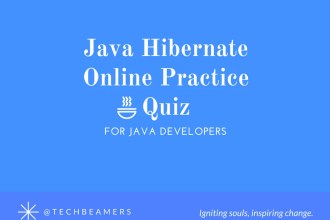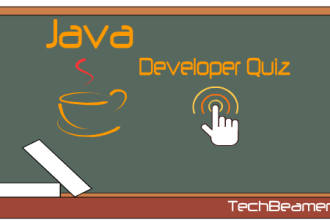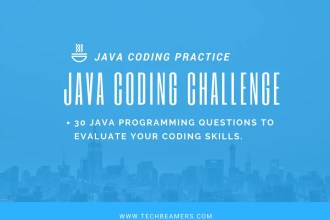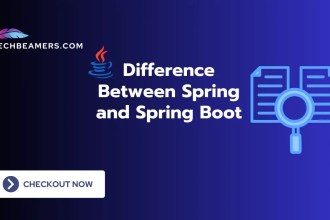Unlock the latest Java Spring MVC Quiz with 20 tricky Java interview questions and see how you score. This online test will check your basic knowledge of Spring MVC which is a design pattern and is one of the most popular spring modules. It’s an action-based framework built as a wrapper over the Spring IOC container. It is one of the most sought-after skills that the interviewers look for in a candidate. Since it’s an MVC (Model-View-Controller) based, it uses three layers to handle different tasks. The Model represents a data model i.e. a kind of data structure. The view layer will fetch the data from the model and refresh the view. The third layer is the controller which takes decisions whether to allow or deny an incoming request. For more info, you must read the best 20 Spring boot interview questions and answers.
Interestingly, Spring MVC is an open source so you can easily download it or get it from Eclipse’s marketplace. In this Java Spring MVC Quiz, we’ve touched on areas like Spring classes, annotations, and some basic concepts. Annotations are magical metadata which does a lot of work in the background. Some of the commonly used terms are @Controller, @RequestMapping, and @ResponseBody, etc. There are several benefits of using Spring MVC than the former technologies like Struts. It provides a clear separation between the controllers, bean models, and views. It is a thin container and doesn’t depend on the application server. Its application code is much easier to unit test. Mockito is a frequently used unit test framework for validating the Spring MVC applications. Let’s now get ready to attempt the Spring MVC quiz.
Also Check: Java Hibernate Test for Beginners
Java Spring MVC Quiz for Beginners
Answer Key with Reasoning
Here is the reasoning table explaining each correct answer briefly and clearly:
| Q# | Correct Answer | Explanation |
|---|---|---|
| 1 | Design pattern | IoC (Inversion of Control) is a design pattern that delegates object creation and dependency management to a framework like Spring. |
| 2 | HTML/JSP | Spring does not directly deal with HTML/JSP; it provides controllers and views but does not render UI. |
| 3 | ApplicationContext extends BeanFactory | ApplicationContext is an extension of BeanFactory, adding more enterprise functionalities like AOP, event propagation, and declarative mechanisms. |
| 4 | Singleton | By default, Spring Beans are singleton-scoped, meaning a single instance is shared across the application context. |
| 5 | Constructor and Setter | Spring allows dependency injection using constructor injection and setter injection to manage object dependencies. |
| 6 | byName, byType, constructor, autodetect | Autowiring in Spring supports byName, byType, constructor, and older versions support autodetect (deprecated). |
| 7 | Compile Time, Classload, Runtime | Weaving applies at compile time, class loading, or runtime, depending on whether static or dynamic weaving is used. |
| 8 | NestedRuntimeException | The parent of all core Spring Framework exceptions is NestedRuntimeException. This class serves as the base for exceptions in Spring, providing support for nested exceptions |
| 9 | An open-source framework | Spring is an open-source framework designed to simplify Java enterprise application development. |
| 10 | Concrete class | Spring controllers are concrete classes, typically annotated with @Controller, @RestController, or @Component. |
| 11 | false | Spring controllers do not need to extend AbstractController. You can annotate any class with @Controller without inheriting this. |
| 12 | None of these. | WebApplicationContext requires key beans like HandlerMapping, ViewResolver, and LocaleResolver, but none are mandatory. |
| 13 | JdbcTemplate | JdbcTemplate is a Spring utility class that simplifies JDBC interactions by handling SQL execution and exception handling. |
| 14 | Using list, set, map, props | Spring supports dependency injection for Java collections like List, Set, Map, and Properties inside beans. |
| 15 | Global-session | In portlet-based applications, the global-session scope is used to share session data across multiple portlets. |
| 16 | Presentation layer | @Controller is used in the presentation layer to handle web requests in Spring MVC. |
| 17 | Maps web requests to methods | @RequestMapping maps HTTP requests to specific controller methods. |
| 18 | true | Annotations in Spring provide metadata that the framework uses at runtime for configurations, bean creation, and dependency injection. |
| 19 | @Autowired is legacy, @Inject is newer | @Inject (Java EE standard) and @Autowired (Spring-specific) both perform dependency injection, but @Inject is newer and recommended. |
| 20 | Maps HTTP requests | @RequestMapping maps HTTP methods (GET, POST, etc.) to controller methods, defining request-response handling. |
Key Takeaways from Java Spring MVC Quiz
Hope, you have enjoyed the Java Spring MVC quiz. The questions in the quiz are not only important for the interviews but you can use this knowledge in real-time Spring MVC projects. While coding, it’ll be helpful if you know the real meaning of the syntax you are using and why you are using it. Also, if you have a good grasp of the concept, then it’s easy to design a solution that is best for your clients.
Before we close for the day, just listen to what the famous Mosher’s Law of Software Engineering has to say.
“Don’t worry if it doesn’t work right. If everything did, you’d be out of a job.”
Keep Learning,
TechBeamers




